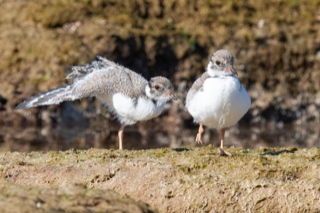Hooded Plovers nest along the Surf Coast beaches during a season that starts in October and can continue to April the next year.
The Hooded Plover pairs select a section of the beach and make a nest called a scrape, above the high tide in the sand amongst the seaweed and detritus on the beach. They usually lay three eggs then alternate sitting on the nest for 28 days.
Once the eggs are hatched the chicks feed themselves with the parents keeping watch. The chicks fledge at about five weeks. Until they are able to fly, the chicks are very vulnerable, and the parents are very diligent in assessing the risk to their chicks. They often divert the attention of other birds by flying away from their chicks and hoping the predator will follow them. The chicks learn to run and hide while their parents lead the enemy away.
 Chicks
Chicks
This season along the Surf Coast between Torquay and Moggs Creek we have had at least six pairs of Hooded Plovers attempt nesting. Many scrapes have been observed by GORCC, Parks Victoria and our monitors who walk our beaches regularly and report to Birdlife Australia on the existence of nests. Unfortunately, many nests have been raided by larger birds such as ravens and magpies before the eggs have hatched. Foxes can also be a problem; however, this season we have noticed far more magpies on the beach than usual. The magpies have been observed working in groups to scare the parent from the nest before raiding the nest.
Hoodie pairs have been observed with scrapes at Whites Beach Torquay, the tip of Pt Roadknight, further along the beach at Pt Roadknight, The Gulch, Fairhaven and Moggs Creek.
Hoodies will attempt to nest several times over a season. The pair at Moggs Creek made four attempts at scrapes. Three times the eggs were taken before hatching. On their last attempt two chicks hatched but were taken by birds, probably magpies, within 48 hours.
The pairs at The Gulch and Pt Roadknight have not produced chicks which is very disappointing as there have been successful fledging of chicks from these sites in the past.
At Whites Beach (Nude Beach) at Torquay, there was a positive result with one chick fledging. This chick has been banded by Birdlife Australia with the flag NB so we may be able to follow its progress in the future.

A pair with white flags, HP and SH have attempted four nests along the beach between the Inlet at Aireys and the Fairhaven Surf Club. The fourth attempt was successful in producing two chicks. At the time of writing the chicks are four weeks old and have been seen flexing wings and making small flights. We are hoping that they will fledge next week which would make three chicks for the season, quite a disappointing result. (Editor note: both chicks did fledge).
 Wing flex
Wing flex
As Regional Coordinator for the Birdlife Beach Nesting Birds Project on the Surf Coast, I have been working with Birdlife Australia, the Great Ocean Road Coast Committee (GORCC), Parks Vic, Surf Coast Shire and volunteers to coordinate the effort to improve the survival rate for the Hooded Plover chicks along our coast.
Once chicks have hatched our wardens go into action. GORCC sets up Dog Exclusion Zones (DEZ) along the beaches where chicks are feeding. This has been an excellent initiative. Our wardens have been able to educate the public about the plight of the hooded plovers as they warden at either end of the DEZ. We have also been able to explain to dog owners why it is essential to keep dogs out of the area where the hoodies are feeding. The chicks need to get down to the wet sand and the rocks several times a day to feed. Even dogs on leads can prevent the chicks from heading down to the beach. Hoodies are able to distinguish between people with dogs and people without dogs and stay away from their feeding area for far longer should there be dogs in their feeding zone.
Generally, the wardens have had very pleasant interactions with the public while being on the beach at the Dog Exclusion Zones. As people become better educated about how the Hooded Plovers breed they are more willing to share the beach and happy to take their dogs to other areas for beach exercise.
Janice Carpenter
Photos: Marg Lacey and Ellinor Campbell